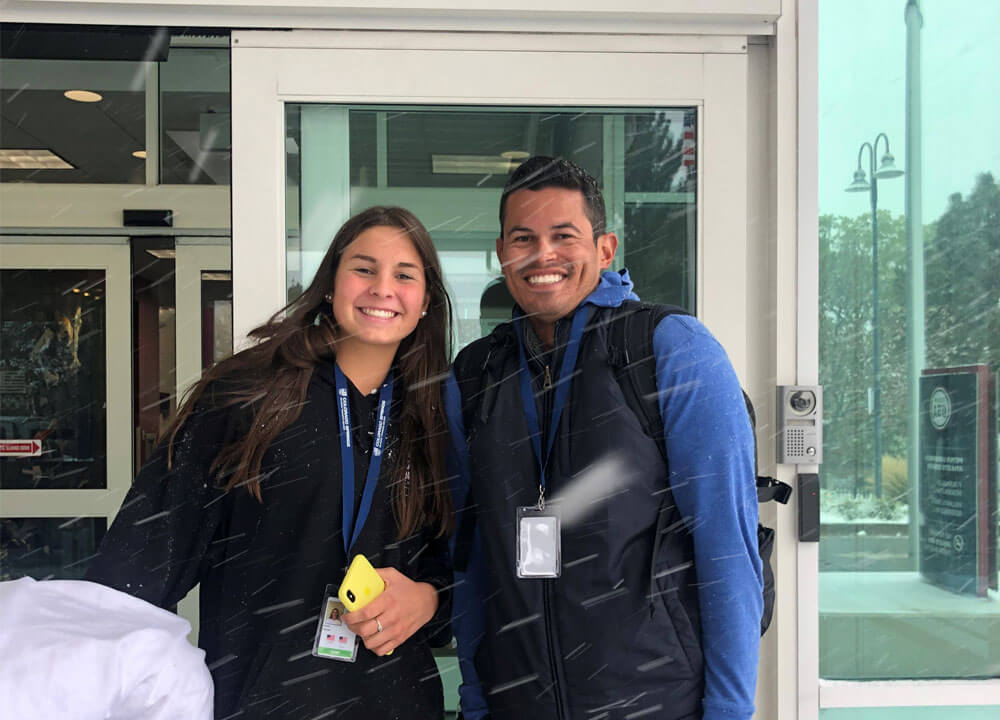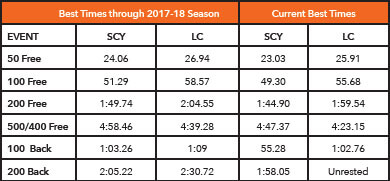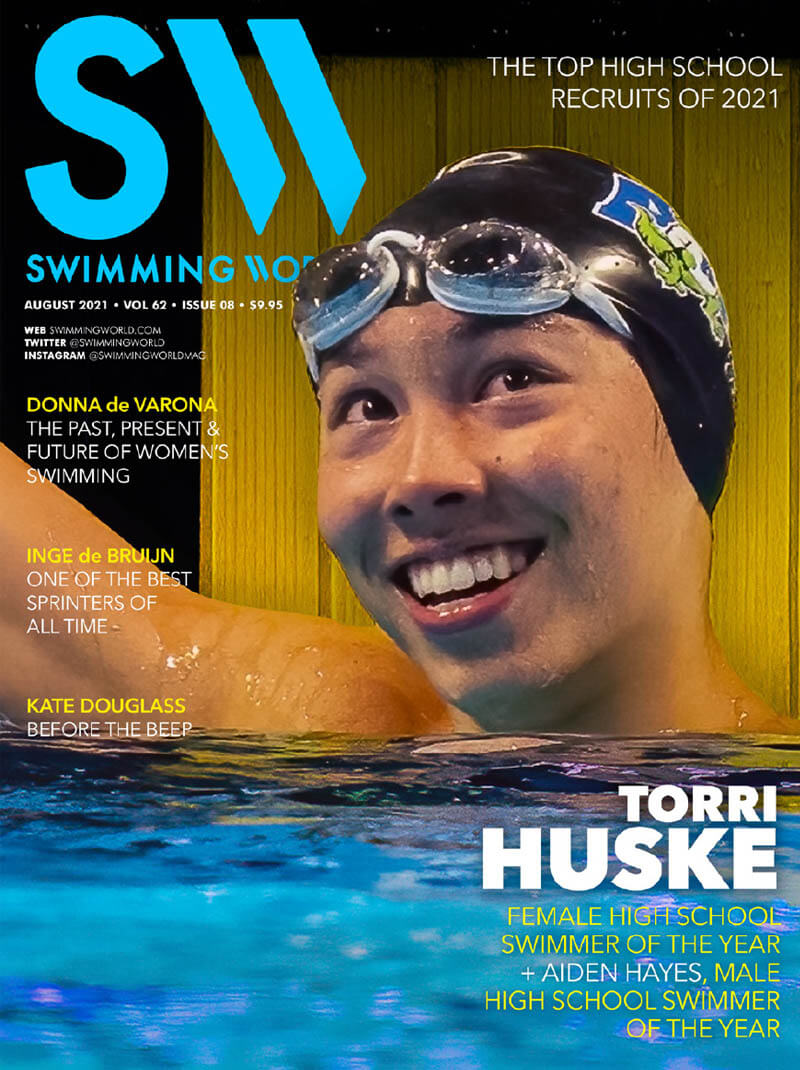Swimming World August 2021 Presents – Special Sets – TIDE Coach Richard Hunter Talks On Training Kayla Wilson

The latest issue of Swimming World Magazine
is now available for download in the Swimming World Vault!
Non-Subscribers Can Download This Issue Here
The Swimming World August 2021 Issue Presents
Special Sets – TIDE Coach Richard Hunter Talks On Training Kayla Wilson
By Michael J. Stott
Coach Richard Hunter of TIDE Swimming in Virginia Beach, Va. discusses goals and workouts for one of his top swimmers, Kayla Wilson, a rising senior at Norfolk Academy who recently committed to Stanford for fall 2022.
Seventeen-year-old Kayla Wilson shares some swimming genes. Her brother, Will, was a multi-time Virginia Independent School champion. Mom, Katy Arris, was a USA Swimming national team member, NCAA 1650 yard freestyle champion and 17-time All-American at the University of Texas.
Kayla herself has compiled an impressive résumé since beginning a competitive aquatic career at age 5. Currently she is a six-time VISAA and six-time Virginia LSC state champion. Her home club is TIDE Swimming, where she has trained with Richard Hunter and the team’s national group since joining as a freshman in 2018.
Following is a snapshot of her improvement in best times:

“As an age group swimmer, we saw a lot of upside with Kayla,” says Hunter. “She was very coachable, had a tendency to swim big and loved to race, especially when it mattered most. She is also one of the most competitive athletes I have ever coached. She has a quiet demeanor and is generally fairly stoic, but she hates losing. She is an athlete who wants the responsibility to anchor every relay.
“When she joined the national group, my job was to improve her in-season racing and give her confidence to perform in practice. Kayla was not bad at practice, but she raced better than she practiced, and had labeled herself as a ‘meet swimmer,’” he says.
THE PLAN
“I set four main goals for her:
“First, I gave her measurable data points so she could monitor improvement outside of competition. She had to learn to train different energy systems and get faster within a given energy system. Kayla had a black-and-white mentality of “I am either going fast or slow” when it came to training.
“We use beats below max (BBM) when asking the athletes to measure heart rate. This gives them training zones that are relevant to them and their individual max heart rates as opposed to just asking everyone to be at a specific heart rate, i.e. 150.
“As an example, Kayla’s max heart rate on a 10-second count is 34 (204/1:00). For our purposes, we use 30BBM as a threshold training zone. Her heart rate in that range is 29 beats in 10 seconds (174/1:00). We use a 10-second count so swimmers can get a quick snapshot of their heart rates during a set rather than waiting a full minute on the wall. So the priority was to get her to go faster in practice, swim more efficiently and increase her training capacity in order to hold a faster time without requiring her to go anaerobic.
“When Kayla started at age 14, she would average roughly 1:09-1:10 per 100 on a threshold set. She currently is anywhere from :59-1:01, depending on the day and phase of our training.
* * *
“Second, I tried to get her to believe in herself in any setting (in-season/champs season, practice/race, etc.). During her freshman year, she struggled adjusting to what was being asked of her each day—not from a volume standpoint, but from an intensity and recovery perspective.
“She felt run down, and was comparing herself with her teammates, many of whom had been training with me for two years. She also had a very narrow scope in terms of what a successful practice looked like.
“For any athlete who is struggling, there is tremendous value in giving them opportunities to figure things out for themselves,” Hunter says. “I look for opportunities to meet an athlete ‘where they are that day.’ For Kayla, at times that meant adjusting the set to ask her to be really good on a few repeats instead of doing the set exactly as written.
Michael J. Stott is an ASCA Level 5 coach, golf and swimming writer. His critically acclaimed coming-of-age golf novel, “Too Much Loft,” was published in June 2021, and is available from Bookbaby.com, Amazon, B&N and book distributors worldwide.
Get Swimming World Magazine and Swimming World Biweekly FREE When You
Become A Member of the International Swimming Hall of Fame
New! 30 Day Membership to ISHOF AND Digital Swimming World Subscription for just $10 a month!
Want more? Get a 1 Year ISHOF Family Membership With Swimming World Print AND Digital Subscription Order Now!
Non-Subscribers can click here to download this issue for only $5.94
SWIMMING WORLD AUGUST 2021 FEATURES
012 | READY FOR A NEW CHALLENGE
by David Rieder
Torri Huske finished her high school career by setting national high school records in the 100 yard fly and 200 IM and by being named Swimming World’s Female High School Swimmer of the Year for the second time (2019, 2021). The 18-year-old senior from Yorktown High School (Arlington, Va.) will be moving on to Stanford in the fall, but first, she set an American record in the 100 meter fly at U.S. Trials that earned her a trip to Tokyo to compete in her first Olympics.
014 | TAKING IT TO THE NEXT LEVEL
by Dan D’Addona
Everything appears to be OK for Norman North (Okla.) High School senior Aiden Hayes. He set two national high school records (100 fly and 50 free) this past season. He competed and gained experience at the U.S. Olympic Trials as the fastest 18-year-old in the country in butterfly. And he was named Swimming World’s Male High School Swimmer of the Year.
016 | CREAM OF THE CROP
by David Rieder and Andy Ross
There were some mighty fast swimmers who finished the 2020-21 high school season right behind Swimming World’s Female and Male High School Swimmers of the Year, Torri Huske and Aiden Hayes. Of the four runners-up, two of them are underclassmen and will be returning for more fast swimming in 2021-22.
018 | TOP HIGH SCHOOL RECRUITS
by Chandler Brandes
Swimming World takes a look at the swimmers it considers to be the 10 best high school recruits—both male and female—from the Class of 2021 and where they’ll be attending college in the fall.
021 | NUTRITION: WHAT TO EAT BEFORE THE “BIG RACE”
by Dawn Weatherwax
To reach your swimming goals, it is important to know what to eat—at what times and in what amounts. It is different for everyone, but very important to master.
022 | ISHOF: THE U.S. OLYMPIC TRIALS—DONNA DeVARONA AND THE PAST, PRESENT AND FUTURE OF WOMEN’S SWIMMING
by Bruce Wigo
At the recent U.S. Olympic Trials, there was one moment that linked the past with the present and future of swimming like no other. It came when Donna de Varona presented Olympic qualification medals to Katie Grimes, the youngest member of the 2021 Olympic swimming team, and three-time Olympian Katie Ledecky.
025 | ONE OF THE GREATEST SPRINTERS OF ALL TIME
by John Lohn
The 2000 Olympic Games in Sydney are widely remembered for the home-nation success of Australia, which was spearheaded by teenage sensation Ian Thorpe. But the Games Down Under also served as a redemptive locale for the Netherlands’ Inge de Bruijn, who used the stage to define herself as one of the sport’s legends.
028 | MENTAL PREP: BEFORE THE BEEP WITH KATE DOUGLASS
by Shoshanna Rutemiller
COACHING
030 | SPECIAL SETS: TRAINING KAYLA WILSON
by Michael J. Stott
Coach Richard Hunter of TIDE Swimming in Virginia Beach, Va. discusses goals and workouts for one of his top swimmers, Kayla Wilson, a rising senior at Norfolk Academy who recently committed to Stanford for fall 2022.
034 | SWIMMING TECHNIQUE CONCEPTS: MAXIMIZING SWIMMING VELOCITY (Part 4)—MINIMIZING THE ARM ENTRY PHASE TIME IN BACKSTROKE AND BREASTSTROKE
by Rod Havriluk
To minimize the arm entry phase time in backstroke, a swimmer must quickly move the hand downward directly behind and below the shoulder. Minimizing the arm entry phase (glide phase) in breaststroke requires precise control of the timing between the finish of the kick and the beginning of the pull. A decrease in the non-propulsive entry phase decreases the time for a stroke cycle, increases stroke rate and increases swimming velocity.
038 | SPECIAL SETS: ENERGY SYSTEM TRAINING
by Michael J. Stott
George Heidinger, former USA Swimming National Team High Performance Consultant and owner of Pikes Peak Athletics (Colo.), specializes in long-term athlete development. As such, he is well-schooled in the science of energy systems and shares some sample sets he has given to rising high school senior Quintin McCarty and his PPA senior teammates.
040 | A COACHES’ GUIDE TO ENERGY SYSTEMS (Part 3): WHILE THEY’RE YOUNG
by Michael J. Stott
In Part 3 of our series on energy systems, two age group coaches—one from Clovis, Calif. and one from Richmond, Va.—share how they inform and guide their younger athletes through energy system training.
043 | Q&A WITH COACH NICHOLAS ASKEW
by Michael J. Stott
044 | HOW THEY TRAIN: MILES SIMON
by Michael J. Stott
TRAINING
033 | DRYSIDE TRAINING: GOLD MEDAL WORKOUT
by J.R. Rosania
JUNIOR SWIMMER
036 | GOLDMINDS: 10 GREAT REASONS TO GET BACK IN THE POOL
by Wayne Goldsmith
47 | UP & COMERS: BRIAN HAMILTON
by Shoshanna Rutemiller
COLUMNS
008 | A VOICE FOR THE SPORT
011 | DID YOU KNOW: ABOUT ETHELDA BLEIBTREY?
046 | HASTY HIGH POINTERS
048 | GUTTERTALK
049 | PARTING SHOT
Swimming World is now partnered with the International Swimming Hall of Fame. To find out more, visit us at ishof.org




